What does a Tatar kermek look like and how to grow it?
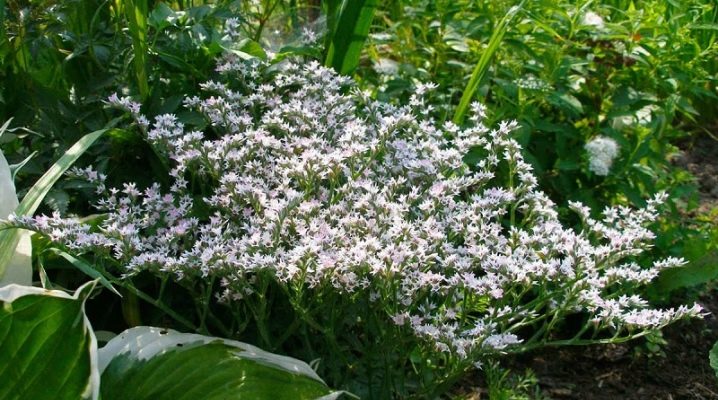
Many varieties of perennial grasses look very interesting and decorative. These include the Tatar Kermek. The plant attracts attention with its large leaf plates and small neat flowers. In today's article we will find out what the Tatar Kermek looks like and how it can be grown.
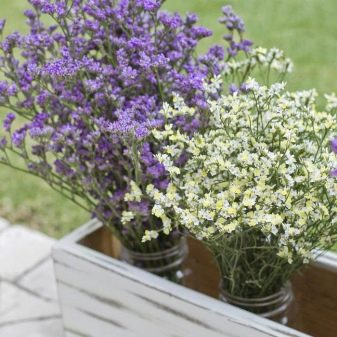

general description
Kermek (or limonium) Tatar is a perennial herb, a little less often a shrub. The foliage of this plant is rather large, with a lanceolate structure. Large leaf plates of the kermek are located in its root zone. These components are characterized by a dense leathery structure, as well as a neat glossy sheen on the surface. The shade of the leaf plates can be green, bright light green or emerald gray. Kermek Tatar has thin and flexible stems. They are well branched and green in color. The height, as a rule, reaches no more than 50 cm. The bush itself is distinguished by an attractive spherical shape.
The flowering period of Kermek Tatar begins with the beginning of the summer season. Panicle-shaped inflorescences are located at the ends of the shoots. Kermek flowers grow miniature, consist of five petals. Their structure resembles bells with threadlike stigmas. The colors of these elements can be different. Flowers of white, cream, light pink, rich cornflower blue and soft lavender shades look very beautiful. There are a sufficient number of varieties in which flowers of different colors can be present on one inflorescence, for example, blue and snow-white.
The plant in question is characterized by a very powerful root system. It goes deep into the ground. Due to this feature, transplanting an already adult bush is impossible, since it is extremely difficult not to accidentally cause serious damage to the roots.
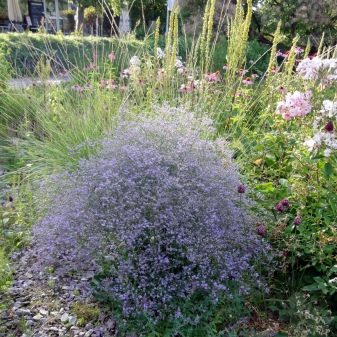
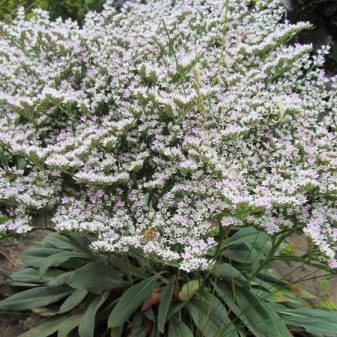
Popular varieties
There are many attractive and popular kermek varieties. Each of them has its own distinctive characteristics and features of appearance. Consider what data the most popular plant varieties have.
- Caspian. The specified Kermek variety belongs to the category of perennial plants. The height of the Caspian bushes rarely reaches more than 0.5 m. The plant produces neat flowers, painted in a pleasant soft lavender shade. Light purple flowers may also develop. Inflorescences are characterized by a thyroid structure. The Caspian kermek attracts attention with compact and very beautiful balls covered with miniature flowers. Such a plant looks elegant and very delicate, so with its help you can effectively decorate your landscape design.
- Sinuate. This popular Kermek variety is an annual. It is a rather tall dwarf shrub. Usually its height is no more than 80 cm. The plant produces attractive inflorescences with a shield structure. The petals of the buds here have a beautiful rich cornflower blue color, which immediately attracts a lot of attention. The perched variety of Tatar Kermek can serve as a wonderful decoration for a front garden or a well-groomed green garden. Landscape designers are very fond of this annual for its decorativeness and pleasant color scheme.
- Gmelin. This variety belongs to the category of perennials.It is a low-growing plant that forms compact and very neat bushes. They rarely grow above 30–40 cm. The leaf plates of the variety in question develop large-sized, having a very attractive emerald color. They form a rosette in the root zone of the plant. The stems of the Gmelin variety are strewn with small, but very beautiful flowers of delicate violet and lilac shades.
The roots of the Kermek in question are strong and strong. The corymbose shape is characteristic of the inflorescences of the variety.
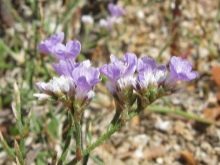
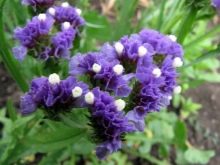
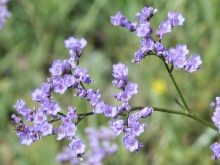
Landing
Kermek Tatar is a plant that is primarily intended for cultivation in open ground. Too high humidity levels in greenhouses, as well as a lack of sunlight inside dwellings, can negatively affect the development of culture. It should be borne in mind that the Tatar Kermek demonstrates an increased sensitivity to the length of daylight hours, shady places for the plant turn out to be completely uncomfortable. Planting and grooming procedures for kermek are carried out without unnecessary difficulties.
Seeds for planting Kermek Tatar can be safely planted in the soil layer in the spring season. This is best done when the snow melts and the soil has time to warm up to comfortable parameters. Based on the specific region and weather conditions, months such as April or May are appropriate. In the southern territories of the country, seeds of the Tatar Kermek can be sown already in March. Sowing before winter is also common, in the last days of the autumn months, when cold weather conditions become stable and prolonged. In such a case, seedlings of kermek are formed much more "together", develop very strong.
Before planting a Tatar Kermek, it is important to choose the right place for it on the site. The plant loves to be in open and well-lit "squares". If the culture does not receive enough sunlight, it will begin to stretch and turn ugly. At the same time, the flowering of kermek is suspended. The planting site must be dry. Ground water should not pass nearby or moisture from rains should not accumulate. If the land is located in lowlands, then the flower beds will need to be raised by at least 0.5 m.
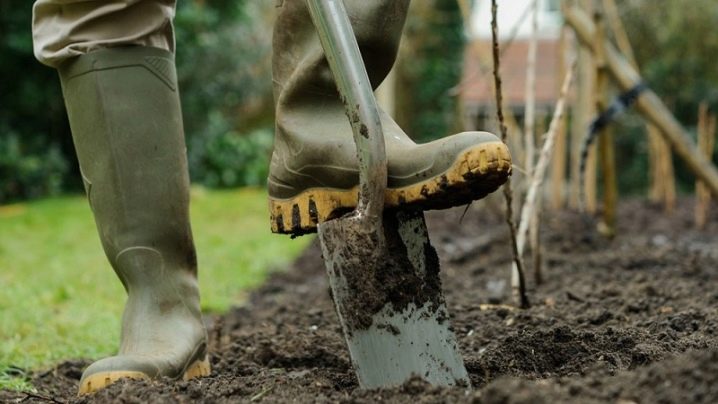
Before planting the plant, the site will need to be carefully dug up. All weed roots should be removed. Kermek Tatar is allowed to be placed on almost any type of soil. The only exception is dense clay, not supplemented with fertilizers. Sandy and loose soil mixtures with a good drainage layer are best suited for the bush in question.
If a suitable area for the plant is selected, you can start planting it. Let's understand the basics of this procedure.
- Seedling material should be planted in separate holes. In this case, it is necessary to maintain a distance of 0.5 to 0.8 m from each other.
- For plants, it is necessary to make fairly large holes so that a clod of earth can fit in them. The root collar should be flush with the surface. In this case, the leaf outlet is not allowed to deepen in the hole.
- Kermek Tatar seedlings are placed one by one in the hole. At the same time, it is important to maintain a distance so that later the sprouts have enough free space for further development, climb.
- After placing in the holes, the seeds are covered with sand or fertile soil mixture.
- After completing all planting operations, the personal plot will need to be watered with warm water, but it is not necessary to flood the land too much.
The planted seed is covered with oilcloth or glass pieces until the starting shoots break through.

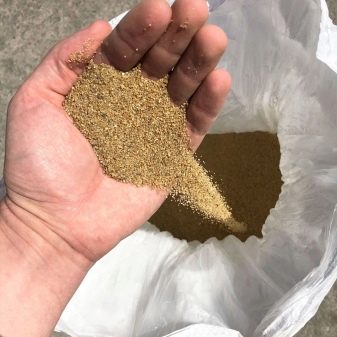
Care
A culture that grows in the open field will definitely require the right attitude towards itself.Kermek Tatar, like any other ornamental plant, will need proper care. They cannot be neglected, as this can cause very serious harm to the landing.
Let's consider the basic nursing operations, without which the Tatar Kermek cannot be left.
- If the plant develops in a fertile soil mixture, then the addition of additional feeding agents is not required. Kermek Tatar can grow normally without them.
- If the soil in which the plant is located is depleted, then it can be supplemented with a small amount of complex fertilizers during planting, as well as monthly during the growing season.
- The plant in question tolerates dry conditions and heat without unnecessary problems, however, excessive waterlogging for kermek is destructive. Additional moisture is practically not required for the culture, especially if rainy weather is established. Watering of Kermek Tatar should be carried out only 2-3 times during the entire summer season, when the soil dries up significantly and the foliage begins to wither.
- When watering the bush, it is very important to ensure that water does not fall on the leaf blades or stems, as this can lead to their rotting.
- The pruning procedure is important for the plant. In autumn, when the branches of the kermek are bare, the aboveground part is cut off. In this case, it is necessary to leave stems with a height of 3 to 5 cm.
- In order for the decorative culture in question to easily endure the winter season, it must be properly prepared for it. Kermek Tatar should be covered. For this, straw, spruce branches or a special non-woven material are suitable. The shelter can be removed when all the snow has completely melted.

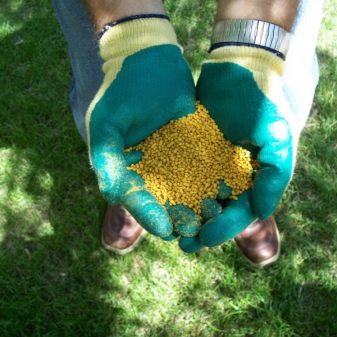
Reproduction
Reproduction of limonium tartar can occur through seeds. Most often, gardeners resort to this method, since the root of the plant rhizome is deepened to a great depth, as a result of which a transplant with division turns out to be completely meaningless. Bushes that have damaged roots cannot be propagated - they simply cannot develop normally.
Diseases and pests
The culture in question is characterized by good resistance to various diseases and pest attacks. Most often, the cause of the developed diseases of the Tatar Kermek is too abundant watering. In this case, the bushes can be affected by dangerous fungal infections, as well as mold. Fungicidal agents, as well as a solution of copper sulfate, will help to cope with fungi. If the plant was affected by white or black mold, then it can be treated using colloidal sulfur.
If the Tatar Kermek is too weak, then it can be attacked by aphids. This is especially true when there are a large number of anthills on the territory of the site. With these problems, people often turn to various folk methods and recipes, treat the bushes with water, soap and alcohol.
Also, insecticide preparations can be effective in the fight against a wide variety of parasites and insect pests. Most often they are sprayed with bushes.
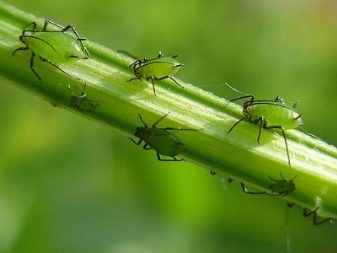
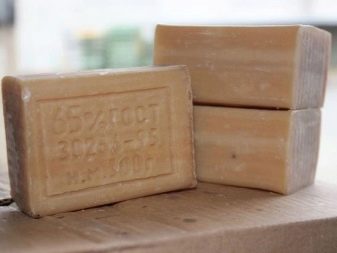
Application in landscape design
Kermek tatar is a very attractive plant that is difficult to miss on the territory of the local area. For its beautiful appearance, this green handsome man is so popular with designers working on decorating landscapes.
- Basically, the decorative Tatar kermek is used in landscape design to form spectacular rockeries, as well as fashionable alpine slides. The latter look especially impressive and harmonious if limonium is present on them. In addition, the culture in question fits incomparably into mixborders.

- Most often, gardeners and florists decorate with Kermek Tatar different types of flower beds displayed on the site. Such simple decorations can give the area a more elegant and welcoming look.Also, the plant can be a chic decoration for a green lawn. Kermek Tatar looks especially interesting and bright if it is in the vicinity of dwarf varieties of conifers.
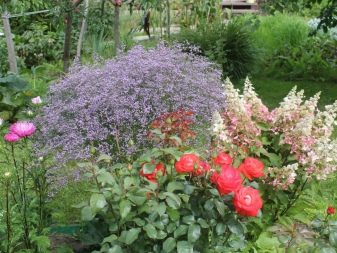
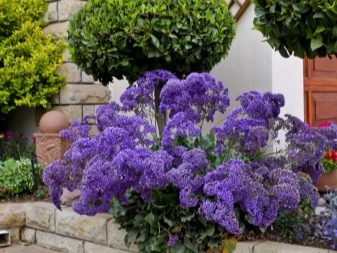













The comment was sent successfully.